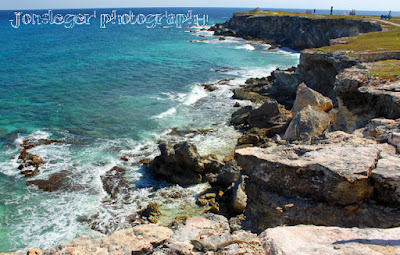Happy New Year's Eve day!
 |
| Sunset from the boat returning from the nature preserve, Isla Contoy, Mexico; 12/21/10. |
 |
| View of the Caribbean Sea from the deck of our room in Cancun, Mexico: 12/19/10. |
I'll divide my birding exploits into five areas and then spend the next several weekends showing some of the better photographs. Also everywhere we went, there were sure to be some iguanas hanging about (Below).
 |
| An iguana showing off on Isla Mujeres, Mexico; 12/20/10. |
As expected, being located just off the Caribbean Sea coast, many of the birds that I saw in Mexico were shore or water birds, but I am happy to report that I also saw lots of land birds new to me.
* Denotes a new species of bird for me to add to my Life List.
1. Birds that I identified just around Cancun where we stayed: Brown Pelican*, Magnificent Frigate bird, Double-crested Cormorant, Great Egret, White Ibis*, Osprey, Great Kiskadee*, Tropical Mockingbird*, Great-tailed Grackle*, Tropical Kingbird*, Yellow-bellied Sapsucker*, Bat Falcon*, Sandwich Tern*, Laughing Gull*, American Golden Plover*, Yellow Warbler, and Ruddy Ground Dove*; there were a couple of species of Orioles that I am still trying to make a positive ID, and several hummingbirds that eluded my camera and my ID skills.
 |
| The northeastern coast of Isla Mujeres, Mexico; 12/20/10. |
3. Isla Contoy (Below top) is a fantastic island that is entirely preserved as a sanctuary for wildlife. We took a boat tour (about 90 minutes one way) to Isla Contoy which is the prime habitat for the Magnificent Frigatebird (Below bottom), but also is home for many other birds at various seasons of the year. Birds that I identified on Isla Contoy: Brown Pelican, Great-tailed Grackle, Double-crested Cormorant, Roseate Spoonbill*, Reddish Egret*, Great Blue Heron, Osprey, Ruddy Turnstone, Yellow Warbler, Palm Warbler, Great Egret, Tropical Mockingbird, as well as much marine life: jellyfish, manta ray, a school of sardines, sand shark, needlefish, and many hemit crabs and iguanas.
 |
| A view of Isla Contoy from the tower at the Preserve's headquarters, Mexico; 12/21/10. |
 |
| Magnificent Frigatebirds swarmed the sky over Isla Contoy, Mexico; 12/21/10. |
4. Birds I identified while visiting the famous Mayan city ruins, Chichen Itza [which is home to the great Kukulkan Pyramid (Below), one of the Modern Seven Wonders of the World] and the surrounding area: Great-tailed Grackle, Yellow-faced Grassquit*, Ovenbird*, and several hawks that I was unable to ID.
 |
| One of the "Modern Seven Wonders of the World," the Kukulkan Pyramid in the center of the ancient Mayan city of Chichen Itza, Mexico; 12/22/10. |
5. Val and I took a fantastic tour into the Yucatan jungle and marsh (near Puerto Morelos) for the sole purpose of photographing birds (Below). We had a fantastic guide named Luis Ku who is an expert on the birds that live in the Yucatan Peninsuala, whether they are endemic to the area or spend their winters there. In a matter of just a couple of hours, Luis identified over 50 species of birds. Of these, 26 were new to me to add to my Life List. The birds that he identified were as follows: Green Jay#, Wilsons Warbler#, Yellow-tailed Oriole#, Yucatan Flycatcher*, Summer Tanager#, Clay-colored Robin*, Anhinga*, Tri-colored Heron*, Green Heron, Great Blue Heron, Little Blue Heron*, Glossy Ibis(I saw this one, Luis didn't see it)*, American Coot, Northern Jacana*, Black-necked Stilt, Belted Kingfisher, Double-crested Cormorant, Plain Chachalaca*, Yellow-headed Vulture*, Bat Falcon, Ferruginous Pygmy Owl*, Ruby-throated Hummingbird, Buff-breasted Hummingbird#, Black-headed Trogon*, Painted Bunting*, Black-throated Green Warbler, Yucatan Woodpecker*, Golden-fronted Woodpecker#, Rose-throated Becard*, White-eyed Vireo, Barn Swallow, Gray Catbird, Black Catbird*, American Redstart, Yellow-faced Grassquit, Rose-breasted Grosbeak, Blue Bunting*, Melodious Blackbird*, Green-backed Sparrow*, Great-tailed Grackle, Northern Parula, Brown Jay*, Tropical Mockingbird, Great Kiskadee, Killdeer, Northern Waterthrush*, Cavinet Emerald hummingbird*, Yellow-throated Euphonia*, Least Sandpiper, Olive-throated Parakeet*, Turquois-browed Motmot*, Greenish Elaenia*, and Crouch's Kingbird*. Whew!













































